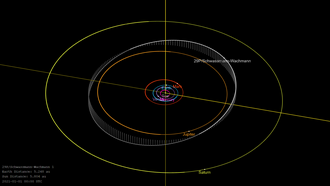29P/Schwassmann–Wachmann
Arnold Schwassmann d |
The comet is a member of a class of objects called "
The comet nucleus is estimated to be 60.4±7.4 kilometers[3] in diameter.[5]
Outbursts
The comet is unusual in that while normally hovering at around 16th magnitude, it suddenly undergoes an outburst. This causes the comet to brighten by 1 to 5 magnitudes.[10] This happens with a frequency of 7.3 outbursts per year,[10] fading within a week or two. The magnitude of the comet has been known to vary from 18th magnitude to 10th magnitude, a more than thousand-fold increase in brightness, during its brightest outbursts. On 14 January 2021, an outburst was observed with brightness from 16.6 to 15.0 magnitude, and consistent with the 7.3 outbursts per year noted earlier.[11] Outbursts are very sudden, rising to maximum in about 2 hours, which is indicative of their cryovolcanic origin; and with the times of outburst modulated by an underlying 57-day periodicity possibly suggesting that its large nucleus is an extremely slow rotator.[12]

References
- ^ a b "Horizons Batch for 29P/Schwassmann–Wachmann 1 (90000393) on 2035-Feb-18" (Perihelion occurs when rdot flips from negative to positive). JPL Horizons. Archived from the original on June 17, 2022. Retrieved October 1, 2021.
- ^ 29P past, present and future orbital elements
- ^ S2CID 119298410.
- ^ a b c Kronk, Gary W. (2001–2005). "29P/Schwassmann–Wachmann 1". Archived from the original on October 22, 2008. Retrieved October 13, 2008. (Cometography Home Page)
- ^ a b c "JPL Close-Approach Data: 29P/Schwassmann–Wachmann 1". Retrieved May 5, 2009.
- ^ "Opposition for 29P (90000394) in December 2022". JPL Horizons. Retrieved February 24, 2023.
- ^ "JPL Small-Body Database Search: orbital class (CEN)". Jet Propulsion Laboratory. Retrieved August 13, 2018.
- ^ "Twelve clones of 29P/Schwassmann–Wachmann diverging by the year 4000". Archived from the original on June 23, 2015. Retrieved April 30, 2009. (Solex 10) Archived December 20, 2008, at the Wayback Machine
- S2CID 233024896.
- ^ a b Trigo-Rodríguez; Melendo; García-Hernández; Davidsson; Sánchez (2008). "A continuous follow-up of Centaurs, and dormant comets: looking for cometary activity" (PDF). European Planetary Science Congress. Retrieved October 13, 2008.
- ^ Lin, Zhong-Yi; et al. (January 15, 2021). "ATel #14323: Outburst of comet 29P/Schwassmann–Wachmann 1". The Astronomer's Telegram. Retrieved January 15, 2021.
- .
- ^ Trigo-Rodriguez et al., Outburst activity in comets, I. Continuous monitoring of comet 29P/Schwassmann–Wachmann 1 [1]
- arXiv:1009.2381
External links
- Orbital simulation from JPL (Java) / Ephemeris
- 29P/Schwassmann–Wachmann 1 – Seiichi Yoshida @ aerith.net
- 29P monitoring campaign – British Astronomical Association COMET MISSION 29P website
- 29P at CometBase
- 29P at Las Cumbres Observatory(8 Feb 2010 12:23, 60 seconds)
- 29P (Joseph Brimacombe April 18, 2013)




